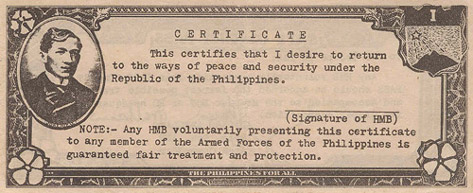Philippines 1950

Safe-conduct pass for Huk guerrillas wishing to surrender
A communist-led peasant movement, abbreviated from its Tagalog acronym as the Huks, had been outlawed and repressed after Philippine independence. The reaction was an insurgency, which gained considerable ground until 1950, when the outbreak of the Korean War led to large-scale U.S. efforts throughout East Asia . In the Philippines , the existing military advisory group, which had existed since independence, was more than doubled in size (though it never exceeded 100 soldiers) and its pleas granted for larger and more rapid arms shipments, including tanks and aircraft. The Philippine army was reorganized into U.S.-style battalion combat teams; an airborne infantry company was set up; and U.S. advisers began accompanying Philippine units into combat. Meanwhile, several officers from the CIA's paramilitary branch were sent to help the Philippine defense minister with political, military, and propaganda advice. 1
1) Valeriano and Bohannan (1962); Greenberg (1987: chs. 5-6); Currey (1988: chs. 3-6). One of the Americans advising the defense minister, Ramón Magsaysay, was Edward Lansdale, who was subsequently sent on a similar mission to the newly-installed president of South Vietnam, and who then was assigned to post-Bay of Pigs operations (“Operation Mongoose”; see chapter six) to overthrow the Castro regime in Cuba.
